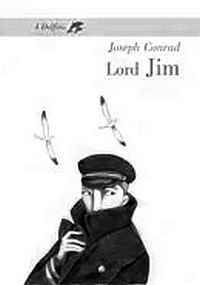 When I found out that there was an Italian edition of Conrad’s Lord Jim for children, reading age 10+, I couldn’t rest until I saw it with my own eyes.
When I found out that there was an Italian edition of Conrad’s Lord Jim for children, reading age 10+, I couldn’t rest until I saw it with my own eyes.
Because, really: from age ten? Ten?! And I wondered because, on first reading it at the slightly more mature age of sixteen, I’d found LJ such hard going. I’d also eventually fallen in love with it in several fundamental ways – but, heavens above, it had been hard. And mind, I don’t mean technically difficult to read – although both language and structure are definitely not easy – but emotionally exhausting. And here was this children’s publisher, springing it on ten-year-old kids?
It must be abridged, I told myself, as I searched for it in the children’s rooms at the Library in town. Severely abridged, and pruned, and sanitized… and I shuddered at the notion, and it took me ages to find it – because, having reached this conclusion, I was looking for a small book. What else could it be, to be appropriate for age 10?
 And then a two-inch thick tome caught my eye. But… it couldn’t possibly be, could it?
And then a two-inch thick tome caught my eye. But… it couldn’t possibly be, could it?
And yet. Joseph Conrad. Lord Jim. From a well known publisher. Children’s classics. Age 10+.
Well, it will be printed large, I told myself, as I took it from the shelf. And it will have lots of illustrations, maybe. And teaching guides, and notes, and footnotes, and guided discussions, and… and…
But no. Standard font. A full translation, from what I could see at a first glance. No illustrations. No apparatus. Not a footnote. Not an introduction… nothing. Nothing except the famous Author’s Note from the the 1917 edition, and a four page Afterword from a well-known Italian scholar of children’s literature. Again: could it possibly be?
More than a little puzzled, I repaired with my find to the reading area, and plunged in. The Author’s Note I know almost by heart – and frankly, with its piqued discussion of what is, or isn’t, implausible or morbid, it doesn’t strike me as terribly enticing for a child of ten… So I began from the Afterword – the only thing in the whole book that could have been written with a child reader in mind… 
And found that what the Afterword did was to explain how adventure can, on rare occasions, rise from mere (and quite second rate) fiction to real literature. It explained it in very flowery, very convoluted, very hazy language, using words that few ten year olds would even know. As a way into the story for the kid reader, it didn’t strike me as terribly effective, either…
And then there was the translation itself. I didn’t read much of it – just samples here and there, enough to decide that not only was it rather wooden, but also peppered with mistakes. Take the ending, where the translation speaks of Doramin and his friend’s son… I don’t know, maybe it was a typo (in my sample reading I’d come across quite a few of those, too) – but we all know that Jim is the friend of Doramin’s son, and not the other way around.
Then again, I doubt many kids would have read as far as the ending – and the few brave little souls would have been far too bored and perplexed to worry over who was whose son or friend. Very bored, and very perplexed, because Marlowe has to be the most unlinear of narrators – ever wandering from the path to speculate, consider, and re-frame his narrative; because the language is an endless web of layered complexities; because the whole story is so unrelentingly, hopelessly bitter; because the “adventure” part arrives after several hundreds of pages of torment, and self-doubt, and inquests, and sleepless nights, and musings over human nature; and because, one hopes, few ten year olds can identify with all the anguished regrets, all the yearning for redemption – to say nothing of the bitter, bitter end.
In fairness, though, I don’t see what the publisher could have done to make the whole more palatable for kids. Frankly, what would be the use of an abridged version – except perhaps that of scaring away from Conrad a number of potential future readers, or else of convincing them they’d actually read Lord Jim – which would have been almost just as bad? I really think there is no way on earth to foist Lord Jim on a preteen without either scraping away all the depth, all the torment, all the complexity – or hopelessly confusing the child.
Wouldn’t it have been better if the publisher had left Lord Jim alone? Lord Jim and a number of other novels, really – because, this particularly sloppy operation apart, what Italian publishers seem to have a hard time getting is that certain stories are just not for kids – even if there are ships, and pirates, and jungles in them. There are children’s classics that are just that; there are classics that can be hugely enjoyed by both children and grown-ups; and there are stories that are just not fit for children.
Why can’t we let the children grow with Sutcliff, Verne, some (but not all) Stevenson, and many others – let them grow into the readers that, in time, will enjoy Lord Jim? Or, in fact, not enjoy it at all – but actually understand why they don’t…
